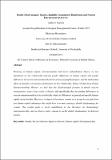Doubly disadvantaged: Gender, spatially concentrated deprivation and nascent entrepreneurial activity
Date
2019-12-02Author
Murzacheva, Ekaterina
Sahasranamam, Sreevas
Levie, Jonathan
Metadata
Show full item recordUsage
This item's downloads: 33 (view details)
Cited 1 times in Scopus (view citations)
Recommended Citation
Murzacheva, Ekaterina, Sahasranamam, Sreevas, & Levie, Jonathan. Doubly Disadvantaged: Gender, Spatially Concentrated Deprivation and Nascent Entrepreneurial Activity. European Management Review, n/a(n/a). doi: 10.1111/emre.12370
Published Version
Abstract
Drawing on human capital, intersectionality and mixed embeddedness theory, we test hypotheses on the
relationship between gender differences in human capital and gender differences in nascent entrepreneurial activity
across geographical space, and the moderating effect of spatially concentrated deprivation on this relationship.
Using UK data from Global Entrepreneurship Monitor, we find that the disadvantaged position of female nascent
entrepreneurs arises from social exclusion, and specifically that the gender differences in nascent entrepreneurial
activity are directly related to differences in general and specific human capital across locales.Moreover, in deprived
locations, women as a group do not gain from any human capital advantage they might have over men, causing a
double disadvantage for women. Our results make a novel contribution to the literature on disadvantage
entrepreneurship, and we discuss policy options to tackle double disadvantage in deprived locales.


